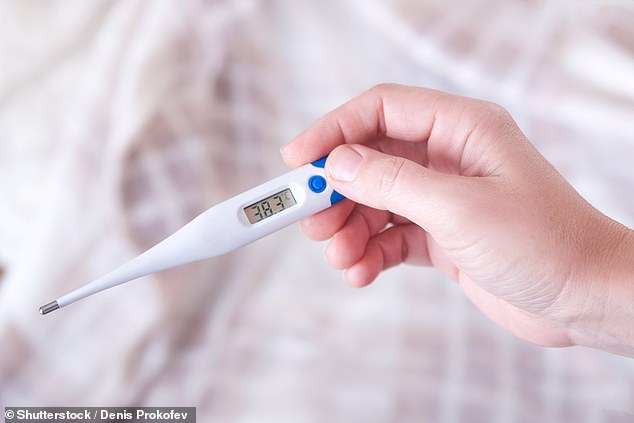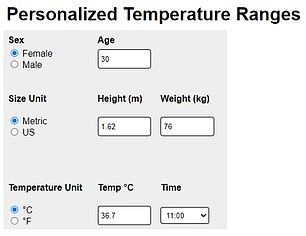Why there’s NO such thing as ‘normal’ body temperature: Scientists reveal it varies by age, sex, height and weight… so use their handy calculator to work out what YOURS should be
Checking whether your temperature exceeds the fever threshold of 38 degrees is a must if you are not feeling well.
But it may be an inaccurate measure of health, scientists say.
American researchers found that ‘normal’ body temperature varies based on age, gender, height and weight – and even fluctuates throughout the day.
This means that some whose temperatures rise when they are unwell may not reach technical fever territory.
One expert said her relative became seriously unwell with a heart infection that went undetected for weeks because her temperature reading was ‘normal’ – even though it was higher than her usual level.
Scientists at Stanford University have now developed a handy tool that allows you to determine what your normal reading should be based on your measurement data.

Checking whether your temperature exceeds the fever threshold of 38 degrees is a must if you are not feeling well. But it may be an inaccurate measure of health, scientists say

The team has created a handy tool that allows you to determine what your normal reading should be based on your readings

The tool allows you to enter your gender, age, height and weight, along with your temperature and the time it was taken
Academics examined 600,000 oral temperatures of adults seen at the Stanford Health Center between 2008 and 2017.
They recorded the time of intake and the age, gender, weight and height of each patient, as well as the medications they were taking and underlying conditions.
Patients taking medications associated with temperature changes were excluded, as were patients with infectious diseases – which typically cause fever.
Results, published in the journal JAMA Internal Medicineshow that adults actually have an average normal temperature of 36.6 C (97.9 F).
For comparison, health chiefs say 37 degrees Celsius is a normal temperature.
The researchers’ analysis showed that men had lower temperatures than women.
It also showed that measurements decreased with age and height, but increased with weight.
But the time of day was the biggest factor in determining temperatures, with people being coolest early in the morning and warmest around 4 p.m.
For example, the normal temperature of a tall, underweight, 80-year-old man at 8:00 a.m. was 36.8 °C (98.2 F), while it was 37.9 °C (100.2 F) for a short, obese, 20 year old woman. at 2 o’clock in the afternoon.
The researchers noted that other factors such as clothing, physical activity, thermometer errors, weather and drinking a hot or cold beverage can also affect the measurements.
The menstrual cycle also affects women’s temperature, raising it by about one degree when they ovulate.
She released a useful tool which allows you to enter your gender, age, height and weight, along with your temperature and the time it was taken.
Then a graph will appear with a black dot showing your temperature.
When the dot falls Below the one percent line or above the 99 percent line indicates an abnormally low or high temperature for someone with your characteristics.
Dr. Julie Parsonnet, senior author of the study and professor of medicine, epidemiology and public health, said: ‘Most people, including many doctors, still think that everyone’s normal temperature is 38.6 degrees Celsius.
“What’s normal really depends on the person and the situation, and is rarely as high as 98.6F.”
That standard temperature is based on data collected in 1868 by the German physician Carl Reinhold August Wunderlich.
He took more than a million temperature measurements from 25,000 patients and noted that men and the elderly had lower temperatures than women and young adults, and that temperatures were higher in the afternoon.
Catherine Ley, senior researcher and lead author of the study, said: ‘Rather than thinking about a temperature distribution, as the first study showed, we took an average of 98.6 F and used this as a cutoff.
‘We used an average value to create a false dichotomy between what is normal and what is not.’
The researchers hope that knowing a person’s normal temperature can make the metric a more accurate and useful vital sign.
This can help detect diseases and ensure treatment starts sooner.
Other experts have previously called for the recognition of a normal temperature range – similar to the range for heart rate and blood pressure levels.
Dr. Parsonnet told how her elderly mother-in-law had a serious heart infection that went undetected for weeks because her temperature never rose above the conventional fever level.
She believes a log of her usual temperature may have helped doctors detect the disease earlier.
The same researchers previously found that the average body temperature in the US has fallen by about 0.03 °C (0.05 F) from 37 °C (98.6 F) every decade since the 19th century.
They believe this is due to better health and living conditions, which reduce inflammation. However, other scientists suggest it may be a measurement problem, as thermometers used in the past were less accurate.
